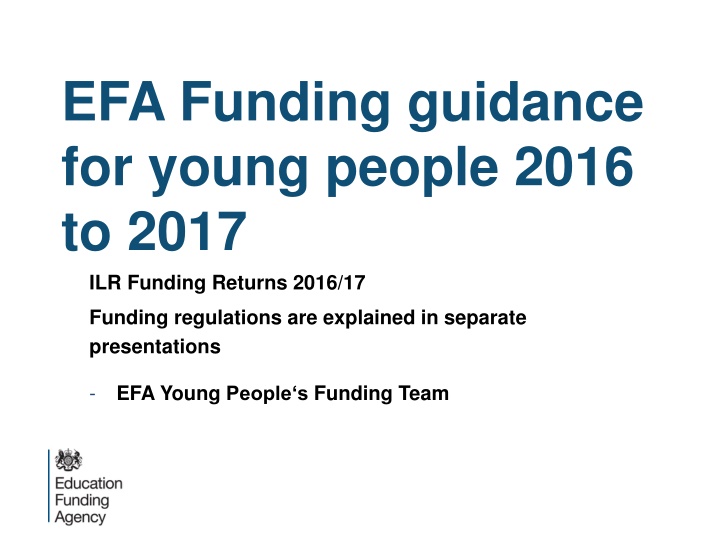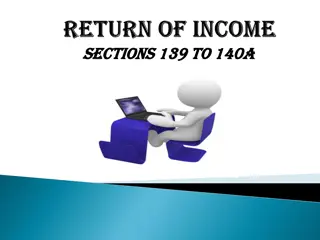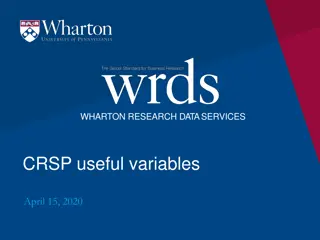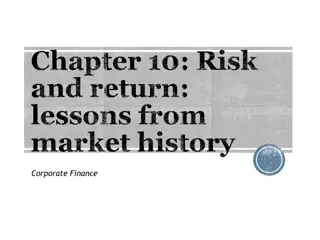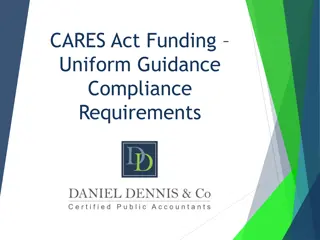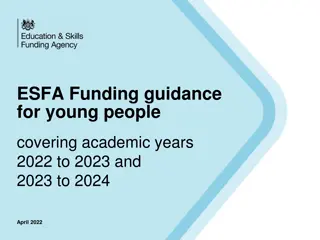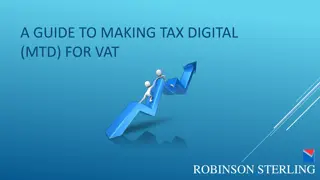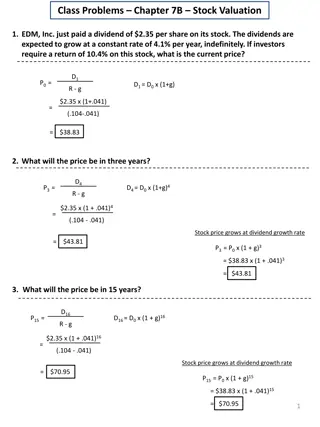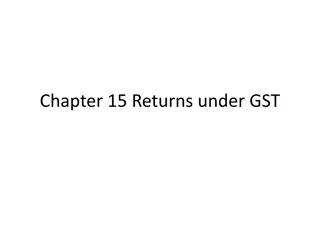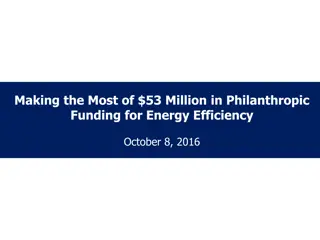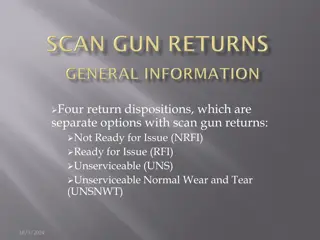EFA Funding Guidance for Young People 2016-2017: ILR Returns & Regulations Explained
Explore the detailed funding regulations and guidance for young people in the 2016-2017 academic year provided by the EFA Young People's Funding Team. The funding guidance covers topics such as funding rates, ILR funding returns, and sub-contracting control regulations. Institutions are advised on funding reconciliation policies to ensure accurate financial records. Learn about how EFA funding is calculated, the timetable for funding returns, and the impact on future funding allocations. Access the necessary documents and information for managing institution funding effectively.
Download Presentation

Please find below an Image/Link to download the presentation.
The content on the website is provided AS IS for your information and personal use only. It may not be sold, licensed, or shared on other websites without obtaining consent from the author.If you encounter any issues during the download, it is possible that the publisher has removed the file from their server.
You are allowed to download the files provided on this website for personal or commercial use, subject to the condition that they are used lawfully. All files are the property of their respective owners.
The content on the website is provided AS IS for your information and personal use only. It may not be sold, licensed, or shared on other websites without obtaining consent from the author.
E N D
Presentation Transcript
EFA Funding guidance for young people 2016 to 2017 ILR Funding Returns 2016/17 Funding regulations are explained in separate presentations - EFA Young People s Funding Team
2 Funding guidance for young people: 2016/17 The format of the funding guidance is the same as last year. It consists of four separate books: Funding regulations (published April 2016) Funding rates and formula (published April 2016) ILR funding returns (published August 2016) this does not apply to schools or academies Sub-contracting control regulations (published July 2016) All these documents are available at: www.gov.uk/16-to-19-education- funding-guidance
3 ILR Funding Returns (by slide numbers) Contents of this presentation Introduction 1 - 3 4 Funding returns timetable 5 - 6 Funding reconciliation policy 7- 9 How is EFA funding calculated? 10 - 22 ILR Funding Returns Annex E technical advice on FIS and ILR data recording 23 - 26 PDSATs ILR data adjustments funding impacts 27 43 Contract institution reconciliation examples
4 Funding return timetable Funding return timetable see Table 1 all institutions The EFA now use the ILR data to monitor and reconcile institutions funding in-year. Final funding values must exactly match between the copied signed funding claim and final ILR data submission. A signed final funding claim return copied and submitted electronically in October as now explained on the website at: How to return ILR final funding claims to the EFA Institution retain the original signed final claim return as part of their financial records. The purpose and reasons for evidencing an original signature on the final claim are explained in Annex A paragraphs 11 to 16.
Funding Reconciliation policy 5 No significant change to existing policy (paragraph references) 21-25 For non- contract funded institutions (colleges, local authorities and HEI) they are not usually subject to in-year or post-year reconciliation (either up or down) but funding recorded in the current year will affect future funding allocations. 26-28 For contract funded institutions (private training organisations and charities now known as CCPs) they are subject to in-year and post-year reconciliation, down and up (subject to affordability), and current funding affects future lagged allocations. Reconciliation compares the overall programme funding out-turn against the overall programme funding allocation. The detailed reconciliation policy, together with some worked examples, are explained in the final section of this presentation
6 How is funding calculated? (slide 1) See Funding rates and formula paragraph 2 The formula Only the student numbers, by bands, on the funding allocation schedule is calculated on an actual basis . The retention factor and programme weighting use the same lagged factor that was used for the purposes of calculating the allocation and these factors are contained within the FIS Report. Area cost will usually be the lagged allocation uplift (although any institution that physically relocates within uplift areas will be considered on an individual basis this is not expected to be an issue for most institutions).
How is funding calculated? (slide 2) 7 See Funding rates and formula paragraph 2 The formula Disadvantage funding is calculated using a combination of lagged and actual data the FIS report uses: The proportion of disadvantage funding as a proportion of whole allocation; and then simply applies this proportion in the same proportion to the out-turn figures. For example, if an institution delivers 110% of their student number funding they will deliver 110% of their disadvantage funding.
ILR Funding Claim 8 FUNDING Claim Report 2016/17 Summary Funding Lines Category Category Each category below is applied to each Funding Each funding line has all 4 categories Line Type Funding value ( ) A 14-16 Direct funded students Funding value ( ) 16-19 Students (including High need students ) B Funding value ( ) C 19-24 High need students Funding value ( ) 19+ Continuing Students (excluding high needs students) D (This is only applicable to Sixth Form Colleges) Total funding (programme funding only) (A +B + C + D)
Annex D: Additional Information Table D 1 (page 25) in ILR Funding returns - summary 9 ILR Field learner funding and monitoring Source of Funding Funding Model A 107 25 n/a HNS Code = 1 or <>1 Type=EHC Code=1 B 107 25 C 107 25 D 107 25 Total (Programme funding only) = A + B +C +D (For C and D students must also be aged over 19 and under 24 on 31 August 2016)
Annex D: Additional Information (slide 1) with reference to the FIS EFA Funding Calculation The Funding Claim Report reporting code takes into account: 10 the split in funding responsibility between EFA and Skills Funding Agency (SFA); that the funding responsibility for students aged 19-24 with an Education and Health and Care Plan (EHCP) remain with the EFA for 2016/17; students who started programmes aged 18 in the first year of their programme but are aged 19 or over on the 31 August 2016 are usually the funding responsibility of the SFA for 2016/17;
Annex D: Additional Information (slide 2) with reference to the FIS EFA Funding Calculation The Funding Claim Report reporting code takes into account: 11 in addition in 2016/17 the funding responsibility for 19+ continuing students at sixth form colleges (as defined in last bullet point on previous slide) is with the EFA and they are funded under the EFA funding model; the ILR fields used to determine into which part of the Funding Claim Report the student and their funded cash appear is summarised on slide 9 and in Annex D (Table D1).
Annex D Additional Information (slide 3) with reference to FIS Funding Calculation 12 FIS EFA Funding Reports - Notes: The FIS Funding Claim Report breaks students down into the full and part time funding bands as shown in the allocation schedule and applies the relevant national rate to each band. In calculating students programme funding out-turn figures the report then uses exactly the same funding factors as those used to calculate the institution funding allocation.
Annex D: Additional Information (slide 4) with reference to FIS Funding Calculation 13 Advice on running and using FIS Reports: The Data Service has issued full guidance on the ILR Funding Claim Report within the FIS 2016/17 Report Guidance, and information on this will be available during the year from: https://www.gov.uk/government/collections/individualised- learner-record-ilr
Annex D: Additional Information (slide 5) (paragraph numbers referenced from Annex D) 14 ILR Data Recording Issues: 4 To keep the Funding Claim Report as simple as possible the report principally looks at ILR fields source of funding , funding model , learner funding and monitoring type and learner funding and monitoring code to determine where each student appears on the report. It also has to reference the individual student s date of birth to assist in determining into which category students belong. 5 To be EFA funded on the Funding Claim Report students must have at least one learning aim coded in the ILR data as set out in Table D1.
Annex D: Additional Information (slide 6) (paragraph numbers referenced from Annex D) 15 ILR Data Recording Issues (slide 1 of 2 on paragraph 6): 6 The disadvantage element is not a funding factor. It is an additional amount of funding that is then included within the overall funding allocation. This requires a different method to calculate a funding out-turn that includes the disadvantage element that also adjusts the overall out-turn figure to reflect the difference between the allocation student numbers and actual student numbers recruited during the year. This is explained in more detail on the next slide which has a reduced font size so Annex D paragraph C fit on one screen.
Annex D: Additional Information (slide 7) (Annex D paragraph 6) 16 the total block 1 and block 2 funding is calculated as a percentage of the programme funding (less disadvantage and before area cost) this percentage is applied by FIS (at the same standard percentage) to each individual student s programme funding (before adding disadvantage funding or using the area cost factor). The standard disadvantage uplift factor for the institution is shown in FIS tables in the column labelled PrvDisadvPropnHist FIS calculates the outturn including both the programme and disadvantage funding. This total is then further uplifted by the area cost factor to produce the outturn.
Annex D: Additional Information (slide 8) (paragraph numbers referenced from Annex D) 17 Condition of funding reductions in allocations and out-turns 2016/17 7 The cash reduction made to 2016/17 allocations for students who did not meet the condition of funding in 2014/15 is also being applied to institutions funded out-turn in 2016/17. 8 This is so the reduction is applied equally to all institutions types in 2016/17. This ensures those institutions that are subject to funding reconciliation are treated equally in respect of the condition of funding as those who are not subject to reconciliation. This deduction will not affect the calculation of lagged funding allocation values for 2017 to 2018
Annex D: Additional Information (slide 9) (paragraph numbers referenced from Annex D) 18 Provider Data Self Assessment Tool (PDSAT) Reports: 14 As stated in paragraph 17 institutions are expected to use PDSAT reports to verify their own ILR data during the year. 15 The software is developed and supported by KPMG. Support is via their helpdesk facility is as detailed on the main PDSAT page, where you can also find a PDSAT e-learning guide: https://www.gov.uk/government/publications/ilr-data-check-that-it-meets- standards-and-quality-requirements The funding impact of how changing ILR data after either institution or funding auditor PDSAT review work is completed is explained in the following slides. The audit evidence needed to support ILR data has similar funding impacts.
Annex D: Additional Information (slide 8) (paragraph numbers referenced from Annex D) 19 ILR Data Recording Issues: 11 All LLDD students (those with an EHCP) aged 19-24 on 31 August 2016 and for whom the EFA has agreed funding responsibility should be coded in source of funding as 107. 12 For sixth form colleges only, continuing students aged 19 or over must be coded in source of funding as 107; the EFA is responsible for funding these students in 2016 to 2017.
PDSATs - ILR data adjustments (which funding year is impacted by ILR data changes?) 20 (slide 1) ILR Data and funding audit recording issues: The ILR data in the current year has two different impacts on an institution s funding from the EFA. Data that affects the current year funding out-turn figure as shown on the FIS Funding Reports particularly the EFA Funding Claim Report. This data also affects forward allocations. Data that only affects the institutions future funding allocation factors, also known as lagged funding factors .
PDSATs - ILR data adjustments (which funding year is impacted by ILR data changes?) 21 (slide 2) Data that impacts on the current year funding out-turn: Student start and end dates determine whether the student completes the necessary start period to count as a funded student in the year. The qualifying periods are solely calculated from the dates recorded in the ILR against the individual student learning aims. Planned study hours for the year determine each student s funding band. If the overall total is amended so that the student is moved into a different funding band (see Funding rates and formula Table 1) then the funding out-turn figure is changed.
PDSATs - ILR data adjustments (which funding year is impacted by ILR data changes?) 22 (slide 3) Data that impacts on the current year funding out-turn: Disadvantage funding is generated exactly in accordance with the proportion of study programme funding generated against the allocation (see slides 16 to 17). Any changes to the funding out-turn from data changes outlined on the previous slide will also alter the current year disadvantage funding out-turn. The area cost factor is usually the same for calculating both current and future funding allocations. Area cost is explained in document Funding rates and formula in paragraphs 69 to 73.
PDSATs - ILR data adjustments (which funding year is impacted by ILR data changes?) 23 (slide 4) Data that impacts only on future lagged funding allocations: Future programme weighting factor is determined by using each individual student s core learning aim to calculate an overall institution programme weighting factor. Future retention factor is determined by using each individual student s retention (based on their core aim) in the current year to calculate an overall institution retention factor. Future disadvantage funding is determined by using all the individual student home post codes and their prior attainment for GCSE English and Maths to calculate an overall institution disadvantage funding figure.
24 EFA Contract institution (CCPs) reconciliation only The rules with some worked examples
Reconciliation rules and examples The principles of CCP funding adjustment and final reconciliation are. 25 In-year payments are made on profile as is planned for all EFA 16-19 funding; in-year delivery of cash is reviewed during the year and where delivery is outside an agreed tolerance, action is taken to adjust the profile of payments from April for the remainder of the year; all funding variances (both in terms of student numbers and cash) are calculated by comparing each whole year delivery (either in-year or at the final return) with the final funding allocation as paid for the year; Only cash is subject to reconciliation ( not student numbers).
26 Tolerance Principles & VfM Contract funded institutions (charitable and commercial providers known as CCPs) The EFA tolerance arrangements for CCPs have been agreed to recognise that minor increases or shortfalls in student recruitment do not result in additional financial costs or savings that are disproportionate to the financial impact from small variances between CCP delivery and allocation figures. Tolerance arrangements need to meet the requirement to safeguard public funding, especially where it is transferring to the private sector, and obtain as much Value for Money (VfM). Institutions are expected to deliver their full allocation each year.
Reconciliation policy for CCPs Contract funded institutions (charitable and commercial providers known as CCPs) (rules detailed in paragraphs 26 34) 27 the following detailed reconciliation rules apply: includes disadvantage funding within overall study programme funding; tolerance for both under and over performance reduced to higher of 1.0% of cash allocations or 5,000; growth subject to affordability.
Reconciliation rules and examples 28 Over performance - paragraphs 32 - 34 For CCPs who have delivered at least 101% of their programme cash allocation a cash tolerance of 1.0% (but with a minimum value 5,000) of the programme allocation will be used when comparing total programme cash delivered against the total cash programme allocation. The cash delivered above the tolerance of the programme funding allocation (together with any FPF) will be paid as responsive growth subject to a growth cap and affordability. The growth cap for contract institutions is normally 30% of the allocation with a minimum value of 100,000 and a maximum value of 1 million
29 Reconciliation rules and examples Underperformance - paragraphs 29 - 31 For CCPs who have not delivered at least 99% of their programme cash allocation a cash tolerance of 1.0% (but with a minimum value 5,000) of the programme allocation will be allowed when comparing total programme cash delivered against the total cash programme allocation. In such cases all the cash not delivered below the tolerance of the programme funding allocation will be recovered as clawback. The following slides include some examples of reconciliation for contract funding underperformance and over performance.
Calculating reconciliation (CCPs) Over performance only 30 Reconciliation calculation (overperformance) Programme outturn ( ) - Allocation (including TP and FPF) ( ) = Variance ( ) (If performance outside tolerance range do calculation below) - (Tolerance in reverse sign to variance) ( ) = Revised Variance ( ) = Cash (responsive growth payment*) (* figure above also subject to a growth cap and to affordability)
31 Reconciliation - Formula Protection Funding (FPF) Over performance only Table 1: FPF examples No FPF FPF + ve 600,000 600,000 1.1 Funding Allocation 0 3,000 1.2 Formula Protection Funding (FPF) 600,000 603,000 1.3 Net Allocation * Funding Allocation (that is being used for over performance reconciliation only) 600,000 603,000 1.4 6,000 6,000 1.5 Tolerance - standard 1.0% Funding Claim (figures from ILR FIS Funding Claim report). 1.6 625,000 625,000 19,000 16,000 1.7 Responsive growth * This slide shows how FPF is used in calculating funding reconciliation for over performance for CCPs only. * All growth payments are subject to affordability and the maximum in-year payment is 50% of the calculated growth value.
Calculating reconciliation (CCPs) Underperformance only 32 Reconciliation calculation (underperformance) Programme outturn ( ) - Allocation ( ) = Variance ( ) (If performance outside tolerance range do calculation below) + (Tolerance in reverse sign to variance) ( ) = Revised Variance (at Full Rate) ( ) = Clawback (a cash recovery adjustment)
33 Reconciliation - Formula Protection Funding (FPF) Underperformance only Table 1: TP examples No TP TP + ve 600,000 600,000 1.1 Funding Allocation 0 3,000 1.2 Formula Protection Funding (FPF) 600,000 603,000 1.3 Net Allocation * Funding Allocation (that is being used for under performance reconciliation only) 600,000 600,000 1.4 6,000 6,000 1.5 Tolerance - standard 1.0% Funding Claim (figures from ILR FIS Funding Claim report). 1.6 560,000 560,000 - 34,000 - 34,000 1.7 Clawback This slide shows how FPF is used in calculating funding reconciliation for underperformance for CCPs only.
Reconciliation examples A to E in the following slides 34 (slides 34-39) The following slides (34 - 39) give some simple examples of CCP reconciliation for 2016/17. For all growth examples all growth payments are subject to affordability and these examples are based on all growth being affordable but this may not be accurate for the final out-turn examples. For CCPs whose ILR R06 funding out-turn is below 60 % of their programme funding allocation will face in-year clawback based on a proportion of their remaining allocation payments from April to July 2017. All final year clawback calculations will be based on final out-turn against final allocations for the year.
35 In-year reconciliation example A (all in ,000) In-year out-turn (ILR figure) Allocation Variance Add in-year tolerance (1.0%) In-year adjustment (Clawback) 900 1,000 - 100 + 10 - 90 Funding out-turn (final Claim) Allocation Variance Add final tolerance (1.0%) Final reconciliation value (clawback) 870 1,000 - 130 + 10 - 120 Final reconciliation cash adjustment - 120 (final) deduct Cash final adjustment (clawback) (in-year clawback) - 90 - 30 * CCPs whose final claims are lower than their in-year funding figure will see no advantage from the final claim calculations from any over statement of their in-year funding.
36 In-year reconciliation example B (all in ,000) In-year out-turn (ILR figure) Allocation Variance Add in-year tolerance (1.0%) In-year adjustment (Clawback) 870 1,000 - 130 + 10 - 120 Funding out-turn (final Claim) Allocation Variance Add final tolerance (1.0%) Final reconciliation value (clawback) 900 1,000 - 100 + 10 - 90 Final reconciliation cash adjustment - 90 (final) deduct Cash final adjustment (re-pay clawback) (in-year clawback) - 120 + 30 * Any clawback calculated from in-year funding figures that is not then calculated from the final claim figures is refunded to CCPs who have increased their delivery above the in-year figure.
37 In-year reconciliation example C (all in ,000) In-year out-turn (ILR figure) Allocation Variance Add in-year tolerance (1.0%) In-year adjustment (Clawback) 900 1,000 - 100 + 10 - 90 Funding out-turn (final Claim) Allocation Variance Deduct final growth tolerance (1.0) Final reconciliation value (growth) 1,150 1,000 + 150 - 10 + 140 Final reconciliation cash adjustment + 140 (final) deduct (in-year clawback) - 90 Cash adjustment (growth & re-pay in-year clawback) + 230 * Any clawback calculated from in-year funding figures that is not then calculated from the final claim figures is refunded to CCPs who have increased their delivery above the in-year figure.
38 In-year reconciliation example D (all in ,000) In-year out-turn (ILR figure) Allocation Variance Deduct in-year tolerance (1.0%) In-year adjustment (interim growth) 1,150 1,000 + 150 - 10 + 140 Funding out-turn (final Claim) Allocation Variance Deduct final growth tolerance (1.0%) Final reconciliation value (growth) 1,250 1,000 + 250 - 10 + 240 Final reconciliation cash adjustment + 240 (final) deduct (in-year growth) + 140 Cash final adjustment (additional growth) + 100 * Any clawback calculated from in-year funding figures that is not then calculated from the final claim figures is refunded to CCPs who have increased their delivery above the in-year figure.
39 In-year reconciliation example E (all in ,000) In-year out-turn (ILR figure) Allocation Variance Deduct in-year tolerance (1.0%) In-year adjustment (interim growth) 1,150 1,000 + 150 - 10 + 140 Funding out-turn (final Claim) Allocation Variance Add final tolerance (1.0%) Final reconciliation value (growth) 900 1,000 - 100 + 10 - 90 Final reconciliation cash adjustment - 90 (final) deduct Cash final adjustment (recover growth and clawback) (in-year growth) + 140 - 230 * No tolerance is available for in-year growth delivery not included in final claim.
40 Adjustments from In-year to Final Claims (CCPs only) Outturn compared to allocation. Shows the alternatives at Final from In-year position FINAL (payment adjustment to take account of in-year clawback) In-year Interim clawback adjustments Under (below tolerance) Within tolerance Over delivery Reversal of in-year clawback and Growth (subject to affordability) No final adjustment other than reversal of in-year clawback Under Clawback Clawback Within tolerance No reconciliation adjustment Growth (subject to affordability) Clawback No final adjustment Clawback No final adjustment other than recovery of interim growth Interim growth (subject to affordability) Growth (subject to affordability) Over delivery Recovery of all interim growth
41 For more information Visit the website to find document publication page: EFA funding guidance: https://www.gov.uk/guidance/16-to- 19-education-funding-guidance ILR Funding returns https://www.gov.uk/government/publications/advice- individualised-learner-record-ilr-returns Funding regulations https://www.gov.uk/government/publications/advice-funding- regulations-for-post-16-provision Rates and formula https://www.gov.uk/government/publications/funding-rates- and-formula
EFA Funding guidance for young people 2016 to 2017 ILR Funding Returns 2016/17 Funding regulations are explained in separate presentations - EFA Young People s Funding Team
